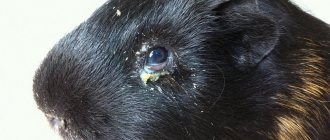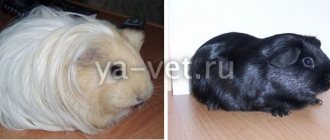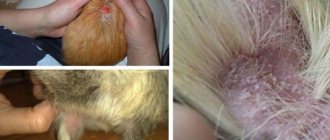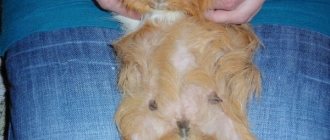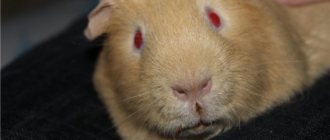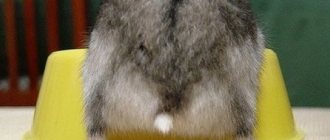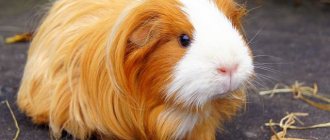- home
- Guinea pig
- Guinea pig health
01/28/2019 Guinea pigs are clean animals with long, thick fur. For their comfortable stay, the owner must regularly clean the cage and monitor the behavior of his pet. Parasites in guinea pigs are of the external type, which is why they begin to constantly itch, threatening to rip their skin until it bleeds. The problem that has arisen must be solved quickly - these rodents have fragile health.
Where do parasites come from in guinea pigs?
Small pets become infected with ectoparasites through contact with infected relatives or dogs and cats, through low-quality litter or hay.
Sometimes parasitic insects, in search of food, enter city apartments from basements and sewers. The owner can infect his beloved animal with external parasites brought on clothing from the external environment. Parasitic insects in guinea pigs, other than lice, are not transmitted to humans, and they do not have the ability to bite people or reproduce on the human body. When lice attack a person they cause pediculosis.
Insect parasitism in pets causes allergic reactions to the waste products of parasites in many owners.
Types of worms
There are two types of worms in pigs: flat (tape) and round. There are many types of flatworms. They usually look like a long strip consisting of several sections. At the end of the body there is a small head with suction cups, with the help of which the parasite attaches to the organs.
Once in the body, the flatworm lays eggs in the animal’s intestines and leaves the body through the anus. The embryos pierce the intestinal walls and enter the lymphatic vessels. In this way, the parasites penetrate the muscles and organs.
Roundworms are thinner than tapeworms and are white or pink in color. They live mainly in the digestive tract, less often in the liver or lungs. The eggs that the worm lays are excreted from the body along with the feces.
Symptoms of guinea pig infection with ectoparasites
Parasitization of different types of ectoparasites on the body of guinea pigs is accompanied by similar symptoms:
- the pet is very worried, often scratches the skin until it bleeds and chews out the fur due to the unbearable itching from insect bites;
- hair loss occurs on the limbs and head, and there is a decrease in appetite and body weight;
- in advanced cases, large hairless areas and purulent wounds form on the skin.
With such symptoms, it is recommended to urgently seek help from specialists. Improper treatment of a guinea pig at home can cause the development of anemia, exhaustion, blood poisoning, intoxication and death.
Common parasites in guinea pigs
The most common parasitic insects of guinea pigs include:
- mites;
- lice eaters;
- fleas;
- lice;
- worms;
- liver fluke.
The last two types of insects are endoparasites. This class also includes Giardia, but they are much less common.
Treatment of parasites in guinea pigs in all cases without exception should be prescribed and monitored by a veterinarian. Only a specialist can specifically determine the type of parasitic insects that cause the infection of the animal. And only a specialist can correctly select the necessary medications and calculate their dosage. The slightest excess of the drug against parasites can lead to severe intoxication and, accordingly, kill the pig faster than the disease. Therefore, self-medication of an animal is strictly prohibited, unless, of course, the owner values the life of his pet.
Ticks
This is the most diverse type of parasitic insects that infect the animal. Ticks are just a unifying concept. In fact, these are several different organisms that serve as causative agents of various diseases. One type of mite causes trixacariasis, another - sarcoptic mange, and a third - demodicosis. In addition to them, there are also ixodid, ear and fur ticks. And we also must not forget about the well-known encephalitis, which is dangerous not only for animals, but also for humans. Symptoms of tick infestation are classic in the presence of ectoparasites.
The causative agents of trixacariasis are found exclusively in this type of rodent, so a guinea pig can only pick up the infection from a sick relative. In an animal with increased immunity, the disease may not make itself felt for a long time, although the parasite that has entered its body will already be doing its job. This disease is most difficult in the following guinea pigs:
- young;
- old;
- pregnant women;
- sick with something else;
- too thin;
- improperly contained.
The sources of sarcoptic mange pathogens are not only infected animals, but also low-quality litter or hay. In addition to the characteristic itching, the disease is accompanied by the formation of light growths on the paws and face.
The causative agents of demodicosis are transmitted again through sick animals. Small guinea pigs often “inherit” the disease from their mother. Signs of the disease are classic. The same goes for fur mites. The symptoms are standard; infection occurs from one animal to another.
Most mites cannot be seen with the naked eye, with the exception of ear mites. What part of the body it affects is clear from the name. The pig becomes infected with the parasite from other animals. The symptoms are different from other types and are very characteristic. A caring owner will immediately notice that the pet is clearly bothered by his ears - he scratches them, often shakes his head, etc.
Ixodid ticks can also be found, but not in the ears, but on the body of the animal. Pets bring this infection from a walk.
Other ectoparasites
Fleas in guinea pigs are most often found of the so-called feline variety, which, despite the name, can parasitize not only cats, but also dogs, rodents and even humans. From them it is transmitted to the pig. The animal can also pick it up on the street. Symptoms of infection are standard. It is easy to detect parasites - just comb the pig well with a fine-toothed comb.
Lice eaters are the causative agents of trichodectosis in pigs. They enter the animal's body through infected relatives, as well as through food, filler or poor quality hay. Parasites can be seen - they are visible when parting the rodent's fur. Their eggs are also noticeable, which can be confused with dandruff. The difference is that dandruff can be brushed off, but parasite eggs cannot be removed.
Lice are also easy to detect in the fur of an animal. Symptoms of infestation by this parasitic insect are similar to classic signs of the presence of ectoparasites. The danger of infecting a guinea pig with lice is that these creatures can be transmitted to humans and cause a serious disease called pediculosis.
Endoparasites
They start in the internal organs of the animal and thus attack the pig’s body from the inside.
There are two types of worms. They enter the animal’s body in the form of embryos along with low-quality food or bad water. Their monstrous abilities give them the ability to move from the intestines to any place in the pig's body, to any organ. Depending on the spread of parasites, the death of the animal can be very rapid. Therefore, at the first suspicion of infection, you should immediately take your pet to a veterinarian.
Another reason to hurry up and visit the doctor is that worms, one of the few types of parasites, can infect a person and have a significant negative impact on the human body.
Signs of an animal being infected with worms, in addition to itching, are:
- weakness, lethargy and apathy;
- loss of appetite, sometimes giving way to barely tamed bouts of hunger and thirst.
When a pig is infected with another endoparasite - fluke - the main symptoms are the same signs, but supplemented:
- nausea;
- high temperature.
The pet also picks up this infection through low-grade food or contaminated water. About a month after the parasite enters the animal’s body, all symptoms weaken or even disappear. But there is nothing to rejoice at - this means that the first stage of the disease is over and the next, more severe one is approaching. Treatment for fluke usually lasts a long time (longer than for worms) and if it is not started in time, the process of destruction of the animal’s body will be irreversible, and it will die.
Trixacarosis
This disease develops due to the bites of a microscopic mite-like mite, which is also scabies. It lives and parasitizes in the subcutaneous layers, the main symptom is hair loss up to local baldness and severe itching. It is important that this mite is found only in guinea pigs, which means you can only get infected from relatives.
If the animal’s immunity is high, this tick is in an inactive phase - its vital activity takes place, but no external manifestations will be detected. Therefore, weakened, young and pregnant animals are most often infected with trixcarosis. There are relatively many signs of damage:
- The affected areas hurt and itch.
- Because of the first point, the pig gnaws these places and pulls out the fur.
- Wounds appear on the skin - with pus and blood.
- Areas of baldness.
- Cramps and miscarriages.
In addition, appetite disappears, the pig loses energy and mobility, and is lethargic. If treatment is not taken, the animal may die from dehydration. For diagnosis, a scraping of the inflamed skin is examined, so a visit to the veterinarian is indispensable.
The doctor will prescribe a number of medications; the owner is required to regularly use them according to the instructions and clean the cage. You need to remove the filler from it, disinfect it and dry it. If there are still guinea pigs living in the house without symptoms of infection with this mite, they need to be isolated from the sick individual and also checked by a veterinarian. Preventing possible illness will save their health.
Sarcoptic mange
This disease is caused by a microscopic mite that gnaws through passages in the subcutaneous layers. Infection occurs through contact with infected animals or through hay. These parasites leave triangular skin growths with a gray crust on the body. This marks their passage into the skin.
The main symptoms are severe itching and alopecia on the animal's limbs and face. Only microscopic examination of a skin scraping can accurately identify this mite. The cage must be immediately disinfected; the veterinarian will prescribe treatment of the fur with acaricidal sprays that contain selamictin.
Demodicosis
The causative agent is a worm-like mite that feeds on the blood of an animal. Infection occurs from neighboring individuals, and in cubs - from the mother. A characteristic sign of the disease is the appearance of papules and pustules on the animal’s body. If left untreated, they develop into ulcers and alopecia, significantly complicating the guinea pig's eventual recovery. Quite often, swelling of the legs occurs (the tick feeds on blood), which is easy to notice by lameness.
Treatment of guinea pigs against parasites in this case is carried out using toxic drugs based on Ivermectin. It is impossible to carry out treatment on your own; an overdose is dangerous for the pet’s life.
Fur mite
This parasite cannot be detected by the human eye, and the symptoms are similar to those listed above - itching, skin ulcers, hair loss and loss of appetite. Only microscopic examination can reveal the exact disease; treatment is carried out with Otodectin and Ivermectin.
Ear mite
A guinea pig can be affected by rabbit ear mites; they appear after contact with a sick animal. You can detect it yourself: dried blood accumulates in the ears, similar in consistency to wax. If you look closely in bright light, you can see tiny brown insects.
Redness occurs on the auricle, and the skin acquires a yellowish tint. The pet tries to scratch its ear and often shakes its head. Therapy is carried out with a course of antibiotics and Ivermectin.
Ixodid tick
This parasite can be “picked up” while walking – it lives in the external environment. A veterinarian can remove it safely and quickly by prescribing symptomatic treatment for rehabilitation. It is not easy to detect it in the thick fur of a guinea pig, so after a walk you need to comb your pet with your fingers.
Ectoparasites
Skin parasites in guinea pigs belong to the group of ectoparasites. The most common among them are lice and ticks, as well as lice and fleas. The first symptom of infection with any of the skin parasites is severe itching, redness and baldness of the infected areas of the skin. Skin parasites cause various diseases, most of which lead to exhaustion of the animal, the appearance of numerous purulent ulcers on the body and even death. Death occurs not only in case of exhaustion, but also as a result of blood poisoning. Various viruses and pathogenic bacteria penetrate into the blood through open wounds and ulcers.
Fleas
Cat fleas are most common in guinea pigs. They can get on the animal from another animal, from the street, and a person can also become a carrier of fleas. Symptoms of the appearance of parasites are itching, local hair loss, and the presence of scratched wounds. If there are too many fleas, this can lead to anemia, exhaustion, and blood poisoning. Detecting fleas is not difficult - you can use a regular fine-tooth comb for fur.
The pig needs to be combed well and checked to see if any insects are stuck between the teeth of the comb.
Treatment of fleas is not complicated, but it requires attention and treatment of not only the sick animal, but also all other pigs. The animal should be treated with any shampoo or spray containing pyrethritol. The entire cage should be washed with the same shampoo, the bedding should be changed and the entire area around the cage should be treated. The procedure should be repeated after ten days and, if necessary, after another ten days. Usually two procedures are enough to destroy not only insects, but also their larvae.
Ticks
Guinea pigs are most often parasitized by two types of mites: the scabies mite and the fur mite.
Scabies mite
The subcutaneous mite in a guinea pig can cause very severe itching. An animal infected with scabies mites can not only injure itself, but also die from severe stress and exhaustion. Symptoms of subcutaneous scabies mite infestation:
- Itching,
- Excessive hair loss
- Skin redness,
- Dry skin
- Increased body temperature
- Refusal of food
- The appearance of papules, ulcers, and wounds on the skin.
Most often, ticks settle in the skin of the head, back, sides and shoulders, but with severe infection they quickly spread throughout the body. Open wounds become a source of penetration of dangerous bacteria and infections into the blood, which increases the risk of secondary infection. If a pregnant female is infected with mites, there is a high risk of miscarriage and subsequent complications. A guinea pig can become infected with ticks from other animals, as well as from humans - insects can live on clothing and even on a person’s body without causing him any discomfort. The presence of a tick in the skin of an animal can only be determined by scraping. Not only the infected guinea pig is treated, but also everyone in contact with it. Usually a ten-day course of ivarmectin injections is sufficient.
Along with the injections, the cage should be thoroughly washed with a solution of lime sulphide or a strong chlorine-containing solution.
Fur mite
The fur mite differs from the subcutaneous mite in its localization - it settles on the surface of the skin. Symptoms of tick infestation include itching and hair loss, peeling and redness of the skin. The animal may refuse food and water and show signs of anxiety. If the infection is severe, purulent, painful ulcers may form on bald areas of the skin. Fur mites are transmitted only through direct contact from a sick animal to a healthy one. Treatment is similar to that for scabies mites. The entire room where the animal was kept should be well treated with a special compound.
Lice
This type of parasite is less common, but is dangerous because it can be transmitted to humans. Lice cause the disease pediculosis, which appears in the form of severe itching, anxiety, and sometimes increased body temperature. Lice are easy to see under a regular magnifying glass. Treating lice is quite easy - if the infestation is not severe, you can try special shampoos and preparations designed for cats or rabbits. However, most often doctors recommend a ten-day course of ivarmectin injections. The guinea pig cage must be thoroughly rinsed with a chlorine-containing solution, and all animals that have been in contact with the infected animal must be treated with shampoo.
lice eaters
Lice eaters are another parasite that often affects the skin of guinea pigs. They feed not only on the secretions of the skin glands and skin scales, but also on the blood of the animal. It is very difficult to detect lice eaters without scraping - they do not exceed one millimeter in length. The first symptoms of infection are itching, severe restlessness and hair loss. If there are a lot of parasites, the animal refuses to eat, sleeps poorly and may die from general exhaustion. Lice-eaters are transmitted not only through contact with animals - a person can bring the larvae or insects themselves on clothing, they can get along with poorly washed vegetables or fruits, as well as on goods from a pet store.
Treatment of lice eaters involves treating all animals, even those not showing signs of infection.
The sprays Akaromectin, Bars and Bolfo have proven themselves well in the fight against lice eaters. The spray is easier and simpler to use than shampoo: guinea pigs do not tolerate bathing well and experience real stress from water treatments. With a spray, the animal can be treated with greater safety and the treatment can be repeated as many times as necessary. In a regular human pharmacy you can also purchase a special anti-lice spray (it also works well against lice-eaters), which contains permethrin. However, most breeders prefer Advocaat drops. They are safer and less toxic for the animal.
Carrying out diagnostics
You can identify fleas yourself. They can be seen with the naked eye on the rodent's face and stomach. If you comb the fur with a single-row, fine-toothed comb, it will leave behind insect excrement in the form of small brown clumps, as well as dead or living insects. Parasites are easier to detect on animals with light fur.
If the diagnosis is carried out by a veterinarian, he takes a scraping from the rodent's skin for examination.
A pig can have several diseases at the same time, for example:
- allergic dermatosis;
- ectoparasites;
- streptococcal infection;
- neurodermatitis;
- mycoses.
Any of these factors, as well as metabolic disorders and poor nutrition, cause itching, sore skin and hair loss.
To determine the presence of the disease, a scraping is taken from the animal's skin.
Video
Authors):
NINA GLOS, Dipl.
ECVD, Fachtierärztin für Dermatologie der Kleintiere EBVS® Specialist for Veterinary Dermatology (Munich, Germany) Journal:
No. 1 - 2018
Materials of the 7th IVDS.
March 9-10, 2022, St. Petersburg, organizer - scientific and practical journal VetPharma translation from English by Anna Gerke
Itching
Parasites (most common)
Rabbits
Ticks
Psoroptes cuniculi
(ear mites, ear scabies): transmission occurs through direct contact. Mostly, the lesions are localized inside the external auditory canal, less often on the scalp. Rabbits may experience shaking of the head, itching of the ears and head, and drooping ears. The ears and ear canal are covered with thick crusts. In rare cases, weight loss may occur. The development of otitis media with neurological disorders is possible.
In the environment, ticks can survive up to 21 days.
Diagnostics: microscopy for the presence of parasites.
Treatment: selamectin: 15-18 mg/kg, topically 1-2 times with an interval of 14-28 days, ivermectin: 0.2-0.4 mg/kg subcutaneously 2-3 times with an interval of 7 days; antibiotics - if necessary; cleansing the ear canal (do not try to remove crusts as this is painful!). All animals in contact must be treated!
Ornythonyssus bacoti
: mainly in wild rodents and animals kept outdoors. Accompanied by severe itching (especially in the evenings), the formation of crusts, and in young animals, possibly anemia.
Diagnostics: identifying parasites is difficult; use a tape test (sampling is best done in the evenings: ticks can be visible in the litter as small dots (white-gray - “hungry”, brown-red - “well-fed”).
Treatment: long-term, over several weeks: selamectin 15 mg/kg every 21 days, several times; ivermectin 0.3-0.5 mg/kg subcutaneously several times with an interval of 7 days. All animals in contact must be treated! Clean the cage regularly and replace the bedding every few days.
Sarcoptes scabiei
: crusts, itchy dermatitis.
Diagnosis, treatment see "Cheyletiella"
;
Leporacarus gibbus
(“fur mite”): asymptomatic in healthy adult animals, the development of the clinical picture is possible with severe infestation (alopecia, exudative dermatitis, itching).
Diagnosis, treatment: see Cheyletiella.
IMPORTANT: Never use fipronil on rabbits. This can be fatal!
Guinea pigs
Ticks
Trixacarus caviae
(guinea pig mange): This is the first differential diagnosis for any guinea pig with itching. A highly contagious parasitic disease for guinea pigs (this diagnosis cannot be excluded even if animals in direct contact do not show symptoms). May cause pseudoscabies (pruritic papular dermatitis) in humans. Under conditions of stress or concomitant diseases, these parasites can multiply rapidly. Infestation can lead to severe itching, hyperkeratosis, peeling, erythema, and alopecia. Complications due to secondary bacterial infection are possible. Common manifestations include decreased appetite, weight loss, apathy, seizure-like attacks, and in rare cases, death.
Diagnosis: microscopy of surface scrapings.
Treatment: selamectin 15-30 mg/kg twice with an interval of 21-28 days; ivermectin 0.3-0.5 mg/kg subcutaneously three times with an interval of 7-10 days. Control of secondary infection. Cleaning cages/equipment (change bedding every few days!).
Chirodiscoides caviae
(fur mite): often asymptomatic, with severe infestation - restlessness and itching, mainly in the back of the back and thighs.
Diagnostics: tape test or macroscopically.
Treatment: selamectin 15 mg/kg twice with an interval of 21 days; fipronil spray 3 ml/kg once; ivermectin 0.3 - 0.5 mg/kg subcutaneously several times every 7-10 days. Treat all animals!
Ornythonyssus bacoti
: See "Rabbits".
Lice
Biting lice: Gliricolla porcelli
(more often),
Gyropus ovalis
(less often),
Trimenopon hispidum
(rarely): clinical manifestations are weak, possibly asymptomatic. They can cause itching, alopecia, peeling, crusting, and in severe infestations, dull hair around the ears and lower abdominal wall.
Diagnostics: tape test or macroscopically.
Treatment: selamectin 15 mg/kg twice with an interval of 21 days; fipronil spray 3 ml/kg once; ivermectin 0.3 – 0.5 mg/kg s.c. several times every 7-10 days. Treat all animals!
Hamsters
Ticks
Notoedres muris
(hamster scabies): severe itching, papules, crusts mainly around the ears, on the face, tail, genital area and limbs. In chronic cases, cauliflower-shaped lesions or cutaneous horns may appear.
Diagnosis: skin scrapings.
Treatment: selamectin 15 mg/kg twice with an interval of 21-28 days; ivermectin 0.3-0.5 mg/kg s.c. 2-3 times every 7-10 days. Treat all animals!
Myobia musculi
(fur mite): often asymptomatic for long periods; possible itching, anxiety, weight loss, crusts, hyperkeratosis, erosion in the head, neck, shoulder blades and back. Diagnostics: tape test, superficial scrapings from the skin.
Treatment: selamectin 15 mg/kg twice with an interval of 21-28 days; fipronil spray 3 ml/kg once; ivermectin 0.3-0.5 mg/kg s.c. several times with an interval of 7-10 days. Treat all animals! Cleaning cages/equipment.
Rats, mice
Ticks
Myobia musculi, Radfordia affinis, Radfordia ensifera
(fur mites): most often (see "Hamsters")
Myocoptes musculinus
(fur mites): often; itching, restlessness, alopecia, erythema, scaling, dull hair in the head, neck, glenohumeral region and sides of the chest, possibly asymptomatic.
Diagnostics: tape test, macroscopically.
Treatment: selamectin 15-30 mg/kg twice with an interval of 21-28 days; fipronil spray 3 ml/kg once; ivermectin 0.3-0.5 mg/kg subcutaneously 2-3 times with an interval of 7-10 days. Treat all animals! Cleaning cages/equipment.
Ornythonyssus bacoti syn. Liponyssus bacoti; Dermanyssus gallina
: they live on the host temporarily, only to suck blood (the rest of the time - in the litter, cracks, crevices). Zoonosis! (See "Rabbits").
Notoedres muris, Notoedres musculi
(ear mites): see Hamsters.
Lice
Polyplax spinulosa, Polyplax serrata
(sucking louse): can act as a vector for
Haemobartonella muris
(in rats) and
Eperythrozoon coccoides
(in mice); causes severe itching, the coat may become dull/sparse.
Diagnosis: macroscopically (adult lice), microscopically (nits).
Treatment: selamectin 15 mg/kg once; ivermectin 0.3-0.5 mg/kg subcutaneously 3 times with an interval of 7 days. Treat all animals! Cleaning cages/equipment.
Ferrets
Ticks
Otodectes cynotis
(ear mites): shaking of the head, itching in the ear area, crusting and scratching in the ear area, possibly asymptomatic.
Diagnostics: microscopy of discharge from the external auditory canal.
Treatment: ivermectin 0.2-0.4 mg/kg subcutaneously 3-4 times with an interval of 14 days; selamectin 15 mg/ferret once. Ear hygiene. Treat all animals, including dogs/cats! Cleaning cages/equipment.
Fleas
Ctenocephalides
sp.,
Pulex irritans
: itching (mainly in the back and neck) and alopecia. For hypersensitivity to flea bites: papules and crusts in the tail area, abdominal wall and inner thighs.
Diagnosis: macroscopically – visualization of fleas or their excrement.
Treatment: imidacloprid 10 mg/kg, monthly, fipronil spray: 1/2 dose for a cat, Lufenuron 45 mg, monthly; selamectin: 6-18 mg/kg, monthly.
Less common parasitic diseases
Rabbits
Haemodipsus ventricosus
(lice),
Ctenocephalides
sp (fleas), especially
C. canis, C. felis.
Spilopsyllus cuniculi (only in contact with wild rabbits, vector of myxomatosis.
Guinea pigs: Polyplax serrata
,
Polyplax spinulosa
(sucking louse): restlessness, itching and crusts; Ctenocephalids canis and felis (fleas).
Hamsters: Myocoptes musculinus
(fur mite): only when kept together with mice.
Rats, mice, hamsters: Trixacarus diversus
,
Sarcoptes anacanthos
: papules, crusts, later hyperkeratosis of the head and limbs with severe itching.
Rats, mice: Ctenophthalmus assimilis
,
Leptopsylla segnis
,
Xenopsylla cheopis
(fleas) – vectors of tapeworms.
Ferrets: Sarcoptes scabiei -
generalized form with focal or generalized alopecia and severe itching. The focal form can affect only the paw pads with the development of swelling, inflammation, itching and damage to the claws. It is possible to develop secondary otitis media or internal otitis.
Environmental factors
(contact dermatitis, litter, allergies)
Rarely. History analysis: data on the use of any aggressive chemicals or detergents.
Dermatophytes
May cause itching (usually trichophytosis). See Alopecia.
Bacterial skin infections
May cause itching, most often Staphylococcus
sp.,
Streptococcus
sp. The root cause must be found.
Clinical signs: erythema, crusts, moist dermatitis, possibly with itching.
Diagnostics: cytology, bacteriology.
Treatment: enrofloxacin 10 mg/kg s.c. or orally 1 time per day for 7-10 days, FERTLES: 5-15 mg/kg s.c., orally every 12 hours; marbofloxacin 4 mg/kg subcutaneously or orally once a day for 7-10 days.
Other causes of itching
Necrotizing dermatitis in rabbits
Presumably of endocrine etiology in non-castrated animals. Often in the spring.
Clinical signs: itching, erythema, crusts on the back and sides.
Treatment: castration. Drug treatment is often unsuccessful.
Ulcerative dermatitis in mice
Presumably an allergic reaction to fur mites.
Clinical signs: intense itching, scratching and secondary infections.
Diagnosis: clinical picture, cytology. Treatment: treatment against parasites: selamectin (15-30 mg/kg) or ivermectin (0.3 – 0.5 mg/kg) subcutaneously three times with an interval of 7 days; antibiotics, for example enrofloxacin; short-acting corticosteroids, for example, prednisolone 1–2 mg/kg subcutaneously or orally once a day.
Alopecia (no itching)
1. Dermatophytes
Trichophyton mentagrophytes
(often in pet stores and laboratories),
Microsporum canis
(in pets),
M. gypseum.
Clinical signs: alopecia, scales, crusts, erythema, papules, change in coat color, possible, itching with trichophytosis, possibly asymptomatic carriage; chinchillas and degus – paw alopecia. Diagnostics: mushroom cultivation (McKenzie sampling), trichoscopy, Wood's lamp examination is not very informative - only 50% M. canis.
Treatment, topical: enilconazole 0.2% once a week until culture is negative; systemically: itraconazole 5 – 10 mg/kg once a day for 4 weeks.
2. Bacterial skin infections
May be accompanied by itching. See Itching.
3. Self-induced alopecia
Rabbits
Alopecia may be associated with pregnancy or false pregnancy (hormonal disorders)
Rabbits, guinea pigs
Alopecia can be caused by a lack of crude fiber, develops in animals that do not receive/receive little hay, and is often accompanied by diarrhea and long teeth.
Treatment: high quality hay, crude fiber content – 16%.
Rats, mice
Trichotillomania (excessive grooming associated with hierarchy): the leader “eats” six from his relatives, while he himself has a normal coat.
4. Demodicosis
Hamsters
Often in Syrian hamsters ( Mesocricetus auratus
)
Demodex aurati
: mite with a long body, lives in hair follicles
Demodex criceti
: a mite with a short body, lives on the surface or in the thickness of the stratum corneum of the skin (Stratum corneum). Contagious! Animals with clinical signs are often weakened by the underlying disease or are immunosuppressed.
Clinical signs: alopecia without itching, erythema, peeling on the dorsal surface of the back, neck, hind limbs, abdomen. Diagnosis: microscopy of skin scrapings.
Treatment: ivermectin 0.3-0.5 mg/kg subcutaneously three times with an interval of 7 days; selamectin 6-18 mg/kg. Treat all animals!
Rabbits
Demodex cuniculi
: rare, usually in immunosuppressed rabbits
Guinea pigs
Demodex caviae:
rare, usually in immunosuppressed gilts
Rats, mice
Demodex ratti
(rats),
Demodex merioni
(gerbils): rare. Contagious!
Ferrets
Two cases of alopecia areata with changes in coat color have been described.
5. Endocrine disorders
Ferrets
Hyperadrenocorticism
Hyperandrogenism (lesions in the Zona reticularis
adrenal gland) is the most common endocrine pathology in castrated ferrets. Supposed reasons: castration (especially early), keeping indoors (exposure to light), genetic predisposition.
Clinical signs: symmetrical alopecia, enlargement of the vulva, recurrence of sexual behavior (rutting), impaired urination in males due to periprostatic or periurethral cysts, enlarged mammary glands in females, itching, sometimes scratching, comedones. Sometimes polyuria/polydipsia, thinning of the skin, muscle atrophy, and loss of coordination develop.
Diagnosis: characteristic clinical symptoms (the most important!), study of hormone levels, ultrasound. Treatment: The preferred method of therapy is a combination of surgery and placement of the Deslorelin implant, a depot analogue of gonadotropin-releasing hormone (GnRH).
Hyperestrogenism
A reminiscent ovary can cause an increase in the size of the vulva and alopecia.
Seasonal alopecia
Manifested from March to August, bilateral alopecia/hypotrichosis of the tail, perineum, abdominal wall (ventral), sacrum can be considered as a variant of seasonal molting.
Neoplasms of the testes
Thinning hair, alopecia, or complete absence of hair on the tail are noted. Sertolioma may cause itching.
Guinea pigs
Ovarian cysts: bilateral symmetrical alopecia of the back and sides, caused by an increase in the level of sex hormones secreted by hormonally active ovarian cysts. Treatment: ovariohysteectomy.
Hamsters
Tumors of the adrenal gland or pituitary gland are noted in 46% of elderly hamsters.
Clinical signs: bilateral symmetrical alopecia, hyperpigmentation and thinning of the skin; the development of polydipsia/polyuria and abdominal enlargement is possible.
Peeling and crusts
1. Parasites: cheyletiosis
Cheyletiella sp: Cheyletiella parasitovorax (rabbits, guinea pigs): also called “fermenting dandruff”, mild to severe flaking and alopecia of the dorsal neck and ventral abdomen are observed. A zoonosis, cheyletiosis is contagious to other animals (eg, dogs, cats).
Diagnostics: tape test, microscopy of scrapings.
Treatment: selamectin 12 mg/kg 1-3 times with an interval of 3-4 weeks; ivermectin 0.3 - 0.5 mg/kg subcutaneously 2-3 times with an interval of 9-21 days. Treat all animals in contact!
2. Syphilis in rabbits
Treponema paraluiscuniculi
(spirochetosis, sin. syphilis of rabbits): a highly contagious disease of rabbits, transmitted through mating. Clinical signs: alopecia, edema, blisters, ulcers, crusts on the face and in the anogenital area.
Diagnosis: clinical picture, dark-field microscopy of scrapings, biopsy with special staining (silver impregnation).
Treatment: penicillin G 40,000 – 80,000 IU/kg subcutaneously, three times with an interval of 7 days (parenteral only! Control of enterotoxemia!). Treat all animals in contact!
3. Hypovitaminosis C (scorbutus, or scurvy) in guinea pigs
A common disease in guinea pigs associated with a genetic defect (deficiency of the enzyme L-gulono-g-lactone), which impairs the conversion of glucose to vitamin C.
Clinical signs: coarse coat, flaking ears, scanty eye/nasal discharge and pododermatitis. Systemic manifestations include anorexia, diarrhea, coagulation disorders, poor wound healing, gingivitis, and lameness. The normal requirement for vitamin C for a guinea pig is 10-20 mg/kg per day. Diagnosis: anamnesis, clinical signs, determination of ascorbic acid content in blood serum.
4. Adenitis of the sebaceous glands in rabbits
Symmetrical alopecia, generalized desquamation and mild erythema.
Diagnosis: biopsy.
5. Lymphoma of the skin
Described in hamsters, rabbits, mice, gerbils.
Clinical signs: alopecia, erythema, peeling. Diagnosis: biopsy
Nodes and tumors
Ulcerative pododermatitis in rabbits and guinea pigs
It develops as a result of violation of living conditions (overgrown claws, obesity, poor hygiene, damp bedding, slatted floors) and improper positioning of the limbs, which leads to inflammation of the pads, bedsores, and is complicated by secondary infections. The lesions are usually bilateral and located on the plantar surface of the carpus/tarsus. The skin may be dry, thin, possibly erythematous, and cracks, crusts, and hyperkeratosis may be present. Such lesions may undergo necrosis, and osteomyelitis and septicemia may develop.
Diagnosis: clinical picture, if necessary, bacteriology.
Treatment: long-term, control of predisposing causes is required. Use local antiseptics, dressings, systemic antibiotics, for example, Enrofloxacin 10 mg/kg subcutaneously or orally once a day for 7-10 days; Marbofloxacin 4 mg/kg subcutaneously or orally once a day for 7-10 days. Analgesics: meloxicam 0.15 mg/kg subcutaneously or orally every 12-24 hours; carprofen 5 mg/kg subcutaneously or orally every 24 hours.
Rabbit myxomatosis
The cause is a virus ( Leporipox
), transmitted by contact with infected animals or through the bites of infected insects (fleas, mosquitoes).
Clinical signs: swelling (of the head, eyelids, external genitalia), discharge from the eyes, skin tumors (dense nodules without itching), lethargy, fever, anorexia, death within 14 days of the onset of the disease.
Diagnostics: clinic, biopsy, virus isolation.
Rat pox
Viral disease ( Orthopoxvirus
): papules (with a depression in the center), crusts, ulcers, necrosis in the head, paws and tail. Zoonosis! In 2009-10 There was an outbreak of the disease in pet rats (infecting people!) in Germany, France and the Czech Republic.
Diagnosis: PCR of crusts (a simple and non-invasive method), immunohistochemistry, electron microscopy, bioassay, serology, virus isolation.
Treatment: if necessary, systemic antibiotics.
Neoplasms
Rabbits: squamous cell carcinoma, basalioma, trichoepithelioma, adenocarcinoma of the sebaceous glands, lymphosarcoma.
Guinea pigs: trichofolliculoma.
Hamsters: melanoma, melanocytoma, epitheliotropic lymphoma
Rats: fibroma, fibrosarcoma, lipoma
Mice: papilloma, squamous cell carcinoma, fibrosarcoma
Ferrets: sebaceous gland adenoma, epithelioma, mastocytoma (benign!), adenocarcinoma, adenoma, cystadenoma, squamous cell carcinoma.
The classification of Professor Steve White was used.
Back to section
What symptoms indicate the presence of fleas
Signs that an animal is being bitten by fleas are as follows:
- redness and peeling of the skin, bite marks (usually on the stomach) in the form of red dots;
- the pig behaves restlessly, shakes its head, itches, eats poorly, becomes less active;
- In places where insects accumulate, hair loss may occur.
Insects pierce the skin and drink blood. The bites are painful, and there are no anesthetics in the saliva. In the affected areas, the skin becomes inflamed, itches, and hurts when scratched.
Flea bites cause red spots on your pig's skin.
What other parasites can pigs get?
Several types of parasites can appear on pigs:
- Ticks. Sources of infection are other animals, human skin and clothing, and poorly washed food. First, mites infest the skin of the head, back and sides, then the entire body. Depending on the species, they settle on the surface of the skin or in the depths, eating away passages in the tissues. Causes severe itching. The animal injures itself with constant scratching, experiences stress, and reaches exhaustion. A pregnant female may have a miscarriage.
- Lice. Insects are yellowish in color, smaller than fleas. Infection occurs through contact with other animals or through bedding. Lice bite into the skin and feed on substances that are released. This causes itching, redness, crusts and papules. With severe infestation, the fur around the ears and lower abdomen becomes dull. Parasites lay white eggs called nits on hairs. Lice living on guinea pigs are species specific. They cannot be transmitted to humans.
- Vlaseaters. These are yellowish-gray worms up to 1 mm long. They hold tightly to the animal’s body with the help of 3 pairs of legs and multiply quickly: 1 female lays about 70 eggs (nits) at a time. They feed on epidermal particles and fur, contaminating the skin and chewing hairs. Causes skin irritation, dermatitis and baldness. Sources of infection are sick pigs, sawdust, and unsealed food. Lice eaters are not dangerous to people.
Ticks can be detected by laboratory testing of skin scrapings or on litter. They look like small dots (hungry insects are gray, and those that have drunk blood are red-brown).
Lice and lice can bring a lot of unpleasant moments to your pets.
Wasting in rodents due to helminths
Helminths force the animal to constantly eat a lot, while the pet will always be hungry. This happens because the helminths literally eat away all the food the pet consumes.
In especially dangerous situations, helminths can develop to such a level that the rodent begins to pass dead worms in feces through the mouth - this is a sure sign of an oversaturation of the body with worms. They no longer fit in the pet, they fall out.
At the same time, worms affect the heart, making it difficult to work and causing discomfort to the rodent, hence the weak activity, drowsiness, lethargy, and apathy.
Worms can also settle in the liver and completely fill the intestines. The absorption of microelements does not occur, since the worms will not allow them to break down to such a state that they can be absorbed.
In especially dangerous situations, helminths can develop to such a level that the rodent begins to pass dead worms in feces through the mouth - this is a sure sign of an oversaturation of the body with worms. They no longer fit in the pet, they fall out. Worms become visible to the naked eye, and you don’t need to go to the doctor to understand what the rodent is sick with.
Methods for removing parasites
For treatment use:
- Shampoo. When bathing, apply to wet fur and rub over the entire body so that it does not get into the eyes and ears. The product must be rinsed off well. When it enters the body, the digestion of animals is disrupted. You need to wash the cage and the area near it with the same shampoo, and change the bedding. The procedure is repeated after 10 days to destroy the larvae. When choosing this method of treatment, one must take into account that pigs are afraid of water and experience stress when bathing.
- Spray. The jet is directed onto the skin against hair growth. Most drugs have an unpleasant odor, so it is better to carry out treatment on the balcony or on the street. The pig should be held in your hands until the spray dries to prevent it from licking the medicine.
- Drops. The dose is drawn into a syringe, the needle is removed, the fur is pulled apart and dripped onto the skin, but not onto the wounds. You need to hold the animal in your hands for about 10-15 minutes until the product is completely absorbed.
- Injections. Subcutaneously into the withers.
Basic rules of treatment:
- at the same time it is necessary to process the hair of all domestic animals;
- every 3 days, disinfect cages and bedding (they must always be dry);
- You cannot use several different drugs at the same time;
- the preparations Neostamazan, Ethnomazan, Stomazan, Butox are not used for pigs (they can only treat surfaces - cages, bedding and other equipment).
The cage must be cleaned every three days.
Used against fleas:
- drops – Advocate, Blokhnet, Stronghold, which can be combined with anti-inflammatory and antimicrobial drugs;
- shampoo “Nizoral” and others containing pyrethritol;
- sprays – 8 in 1, Frontline, Bolfo.
Do not exceed the dose - this can lead to poisoning of the pig. It is better to buy special preparations for rodents. When using medications intended for kittens, take 0.1 ml of Advocate or 6 ml of Stronghold per 1 kg of pig's weight.
Use flea drops in conjunction with antimicrobial drugs.
The above sprays and drops are used against ticks in the same way, as well as injection preparations:
- Ivermectin. Per kg of weight, 0.02 ml of the drug is combined with 0.2 ml of saline solution. The product is considered difficult to use, since it is difficult to calculate the dose and measure it, and exceeding it is dangerous for the pig’s brain.
- Otodectin (variation with 0.1% ivermectin) at the rate of 0.2 ml/kg.
Injections are given once every 10 days, 2-4 injections in total (depending on the degree of damage). Ivermectin is applied to inflamed areas of the skin 2-3 times a day. The cage needs to be washed with a solution containing chlorine and the bedding changed.
The results of scraping tests are positive in only 45-50% of diseases, so the same treatment can be prescribed in case of suspected mite infection with negative results of scrapings. The effect is observed within 3-4 weeks.
Often a tick infection is complicated by the appearance of a fungus. It primarily affects the scalp, neck and extremities. It is treated with Chlorhexidine, Lamizine, etc.
We make injections into the animal's withers.
Help against lice and lice:
- sprays Bars, Celandine, Bolfo, Dana, Akaramectin;
- Ivermectin injections (if there are a lot of parasites);
- Advantix drops, Frontline, Advocate.
If nits are present, the treatment is repeated after 2 weeks. Insecticides kill only adult insects.
The least toxic are pyrethrin-based preparations, such as 8 in 1 sprays and Beaphar. They can be used to treat pregnant and lactating females and cubs weighing up to 500 g.
Sprays against lice and fleas destroy only adult individuals, but not nits.
Preventive measures
Guinea pigs are susceptible to a variety of parasites that live on both their skin and fur. If you properly care for your pet and take preventive measures, the likelihood of parasitic disease will decrease.
It is recommended to treat your pet with a spray if the animal is allowed out for a walk on the lawn in the yard. Washing the cage once a week with flea shampoo will also help prevent the occurrence of parasites. The smell of the product remains and repels pests. Since ticks pose a huge danger, before going into nature it is necessary to treat guinea pigs with a special product. If the pig is in a pen, you should check the animal at least twice a day for the presence of parasites.
Particular attention should be paid to places such as the armpits, stomach and ears. Swipe through the animal's fur. If there is a tick, you will certainly feel it.
Diseases dangerous to humans
Parasites that cause dangerous diseases for humans and live in the body of a guinea pig include:
- Strongyloidiasis,
- Giardiasis,
- Encephalitis.
Strongyloidiasis
The disease is caused by small roundworms that parasitize the small intestine. A person can become infected with worm larvae while cleaning a cage or processing an infected animal. The first and most important symptoms of the disease are nausea, severe abdominal pain, diarrhea, headache and dizziness. If you do not consult a doctor in a timely manner, anemia may develop. Cases of death have been recorded. Guinea pigs can carry larvae without showing symptoms of infection. This happens when the animal has the opportunity to walk in the summer and comes into contact with grass and soil outside.
Giardiasis
A person can become infected with giardiasis during cage cleaning, as well as through contact with an infected animal. The disease is caused by a small parasite that lives in the small intestine and gall bladder.
Symptoms of infection:
- Nausea,
- Stomach ache,
- Bloating, gas formation, constipation and diarrhea, replacing each other,
- Skin rashes
- Fatigue, increased drowsiness, loss of appetite, poor sleep and frequent dizziness.
Tick-borne encephalitis
If a guinea pig walks outdoors in the summer, it needs to wear a special anti-mite collar. Otherwise, there is a high risk that the animal will bring back a tick infected with encephalitis from a walk. This disease is dangerous not only for pigs, but also for humans.
Endoparasites
Endoparasites are parasites that live in the internal organs of a guinea pig. They cause great harm to health and cause not only various poisonings, but also lead to disruption of the functioning of internal organs, as well as the death of the animal. Most often, a guinea pig suffers from:
- worms,
- liver flukes.
Worms
These parasites not only absorb nutrients, but also lead to intoxication and depletion of the body. Typically, guinea pigs are susceptible to infection with two types of worms:
- tape or flat,
- round.
Adult flatworms are parasitic in the intestines and have a ribbon-shaped body. The embryos of worms, having entered the animal’s body along with low-quality food, can drill through the wall of the small intestine and enter the blood. They are able to move freely throughout the body through the circulatory system and settle in the lungs, liver, and brain, which will lead to the rapid death of the animal. Worm larvae are dangerous not only for guinea pigs, but also for humans. An infected animal can be easily identified by lethargy and drowsiness, weight loss, increased appetite and thirst. If the infection is severe, then in the animal’s feces you can see not only worm larvae, but also adult individuals. And with a very severe infection, worms can crawl out of the anus.
Roundworms vary in appearance and can be shaped like a thin thread or a grain of rice. Some are whitish in color and some are pink. Parasites most often live in the intestines, lungs and liver. They lead to exhaustion and blood poisoning, as well as frequent digestive problems and poisoning. Before starting treatment for any type of worms, you should visit a veterinarian to determine the degree of infection. If there are a lot of parasites, special supportive and immune medications may be required. However, if the infection is not severe, then it is enough to give the pig a suspension of prazicide for kittens at the rate of one milliliter per kilogram of the guinea pig’s weight. Dirofen paste has proven itself well. Along with giving the medicine, it is necessary to completely treat the cell with a chlorine-containing solution.
Liver fluke
The liver fluke is one of the most common and dangerous representatives of the species of liver flukes that parasitize the body of mammals. An animal can become infected with this parasite through poorly washed food, as well as through dirty water. Symptoms indicating fluke infection are loss of appetite, as well as lethargy, drowsiness and increased body temperature. Within a month, symptoms may completely disappear, but the parasite will continue to exist inside the liver. Gradually, liver tissue will be destroyed, metabolism will be disrupted, and blood poisoning may occur. Often the liver fluke causes the death of a guinea pig.
Only a veterinarian can determine the presence of fluke in the body after collecting tests, and treatment will depend on the degree of infection of the animal.
Guinea pig treatment
What should I do if my guinea pig has fleas or other ectoparasites? Treatment must be comprehensive. It is not complicated, although the drugs and their dosage are best selected by a veterinarian. There are many products for pigs. The main active ingredient in them is pyrethrin. It is most effective against fleas.
All of these parasitic lesions are treated with external medications. If fleas are found on guinea pigs, treatment should be prescribed by a veterinarian. It is important to determine a safe dose. The animal’s weight, age, health status, and degree of damage are taken into account. If you decide to pick up the drug yourself at a veterinary pharmacy, be sure to check that the label indicates that the drug is used for rodents.
You should not take sprays and drops intended for cats. Their strong concentration can harm the rodent, because it is much smaller. There is a high risk of poisoning.
The following types of drugs are used for treatment:
- medicated shampoos.
- powders;
- sprays;
- drops.
It is better to choose a drug that contains the active ingredient pyrethrin. It is not so harmful, but most effective. There are also products with a synthetic analogue of pyrethrin. They are stronger, but less well tolerated.
It is better to treat the rodent outside, on the balcony or with the window open. Many medications have a strong chemical smell.
When using an insecticide, remember the rules:
- The medicine should not get into the eyes, mouth, or face.
- Direct the jet against the grain.
- Treat all your pets at once.
- After the procedure, hold the pig in your arms until the hair is completely dry.
- It is better to repeat the procedure after a week. By this time, the eggs may hatch into larvae.
Veterinarians sometimes give injections of Ivermectin. Due to toxicity, this method of treatment is used only in cases of severe infection.
Note! Itching, reddened skin can also accompany skin diseases: dermatitis, allergic dermatosis, streptococcal damage, metabolic disorders. If you haven't caught a specific insect, it's best to take your pig to the vet.
Types, symptoms and treatment
As mentioned earlier, pests in guinea pigs can be external (ectoparasites) and internal - helminths and protozoa (endoparasites). Some live on the skin or fur of an animal, others have adapted to parasitize inside the body.
The most common types of ectoparasites in guinea pigs are ticks and lice, and less commonly, lice and fleas.
Subcutaneous mite
It is also called scabies mite. The infestation may come from another sick animal. This parasite causes very severe and painful itching, wounds appear on the rodent's skin from scratching and biting, and some of the hair falls out. A tick cannot be seen with the naked eye, only under a microscope. In a healthy animal with proper nutrition, the subcutaneous mite can even remain inactive for several years. However, as soon as the pig gets pregnant or gets stressed, the problem will come out.
At the veterinary clinic they take a scraping for examination, although it sometimes gives a false answer. In this case, if there are symptoms of subcutaneous mite infection, treatment is carried out for diagnostic purposes. If it gives a positive result, a full course of the drug is prescribed. For treatment can be used:
- Advocate.
- Stronghold.
- Otodectin (solution for injection).
- Ivermectin (solution for injection).
To avoid an overdose and not harm the pet, only one drug is prescribed.
lice eaters
They are a serious threat to the health of guinea pigs. They can be carriers of helminths and fungal infections. The first sign that a lice eater has settled in an animal’s fur is severe itching. The animal seems worried and often itches, causing ulcers and wounds to appear on the skin.
The parasite can be seen with the naked eye by examining the pet's fur. These are small insects up to two millimeters in length, grayish or yellowish in color (depending on the color of the rodent).
If you find a lice eater, there is no need to panic. Today there is a large selection of medicines that can cope with infection:
- Spray Frontline. It is easy to use and most often the therapeutic effect occurs after the first use.
- drops are the most effective remedy. They not only cure the pet, but also prevent the reappearance of pests. Famous brands: Bars, Green Fort, Advantage.
- Among emulsions, Neostomozan is in demand.
- Collars.
- Shampoos.
- Powder.
Fleas and lice
Fleas are more common than lice, but the latter are dangerous because they can also parasitize humans. You can find lice or fleas using a comb. Their appearance is also accompanied by: itching, hair loss and scratching on the rodent’s body. If the infection is not advanced, then treatment will not be difficult.
To get rid of fleas and lice, use a spray or shampoo for cats, which should contain pyrethritol. Both the animal itself and the cage in which it lives should be treated.
Treatment and prevention
Don't panic if you find parasites in a rodent's fur. Today there are a lot of available drugs to kill pests. Remedies for lice for guinea pigs come in the form of:
- sprays, drops;
- emulsions, shampoos;
- collars and powders.
Spray
You can effectively combat the pest using sprays. They are created on the basis of insecticidal components and have a simple method of application. It is enough to spray the rodent’s fur with the solution, then rub it over the entire surface of the skin with massage movements. Most often, just one spray treatment is enough to completely rid your guinea pig of parasites. An example of such a product is Frontline spray.
Spray Frontline
Drops
Treatment for lice in guinea pigs is also carried out with drops containing an insecticide. The drug helps to get rid of not only lice-eaters, but also mites, lice and other skin parasites. The solution is dripped onto the spine in the neck area so that the rodent cannot reach it. Such means are the most effective, as they not only destroy lice-eaters, but also prevent their re-spread. Drops of the Stronghold, Bars, Advantage or Green Fort brands are in particular demand among consumers.
Emulsions
Emulsion is another cure for lice. The concentrated suspension is diluted with water in accordance with the manufacturer's recommendations. It is used to process animal fur. Many consumers prefer the drug Neostomozan.
Shampoos
Shampoos are a safer way to treat guinea pigs. It is preferable to use such detergents for preventive purposes. Since it is not always possible to achieve complete destruction of insects after one application. Lugovoy, Lesnoy or Fitoelita shampoos are very popular among consumers.
Collars
Collars not only get rid of pests, but also prevent re-infestation of lice-eaters in guinea pigs. The disadvantage of this accessory is the possibility of an allergic reaction and irritation in the pet.
Collar Celandine
Powder
A powdered product in the form of powder can not only get rid of pests, but also cure the inflammatory process on the skin, and also reduce the feeling of itching. The rodent's body is sprinkled with powder, trying to rub it into the skin as much as possible. The effect of the drug lasts for one and a half weeks.
To get rid of lice, it is necessary to treat not only the guinea pig, but also the cage in which it is kept. A similar procedure should also be applied to household items with which the animal comes into contact. To do this, you can use Butox 50 solution.
lice eaters
This is another type of parasite that differs in that it can feed not only on particles of the animal’s skin, but also on its blood. Due to the small size of the parasites, it is quite difficult to detect them with the naked eye; you will have to use scraping. The first signs include hair loss of the animal, as well as itching. An animal's reduced appetite threatens death from exhaustion. The danger is that lice can get on the animal even with careful care, for example, through the owner’s clothes or toys from the store.
Comprehensive treatment measures include treating all animals that have previously been in contact with or are close to an infected individual, even if they do not show signs of infection.
Akaromectin, Bolfo and Bars spray can be used as medical assistants in the fight against lice eaters. Due to the fact that bathing is considered extremely stressful for pigs, it is best to opt for a spray, as it will cause them less discomfort. The animal does not resist the procedure and, if necessary, it must be repeated the prescribed number of times. This is usually done by a veterinarian. Lice remedies are also available in human pharmacies, but you need to choose those options that contain the substance permethrin. The largest number of breeders recommend choosing Advocate spray. Due to the content of fewer toxic substances, it is safer for the animal.
Lice eaters are localized in the croup and perineum; they parasitize at the roots of the hair, wrapping their limbs around the hair, and feed on blood, epidermal scales and secretions of the sebaceous glands. As a result, the affected hair falls out. Lice eaters are most active in winter, when the guinea pig's fur becomes thicker and longer, which is a favorable factor for the proliferation of parasites.
Lice feed on blood and are able to actively move around the animal’s body, causing itching. Parasites can be seen with the naked eye when parting the fur, mainly in the head area and around the ears.
Guinea pigs become infected with lice and lice through contact with sick relatives, through bedding and food.
Lice and lice cause itchy skin and severe anxiety in a sick animal, up to the appearance of seizures and convulsions. Fleas with intense infestation can cause inflammation of the skin - flea dermatitis. It is characterized by redness of the skin, baldness, and eczema.
How to withdraw
To treat parasitic infections external preparations are used ; they are sold in a veterinary pharmacy. When purchasing, pay attention to the label; it should indicate that the product is intended specifically for rodents. Drops and sprays for cats contain a higher concentration of the insecticidal substance and can cause poisoning in guinea pigs.
For treatment the following are used:
- Shampoos;
- Sprays;
- Powders;
- Drops.
Are there allergies to guinea pigs?
Preparations containing pyrethrin are considered the least harmful. These include:
- Spray 8 in 1;
- Flea&Tick;
- Spray Beaphar.
Products based on synthetic pyrethrin analogues are more potent. This:
- Frontline;
- Spray "Bars" for rodents;
- Bolfo.
It is better to treat the rodent outdoors or near an open window, since many preparations have an unpleasant chemical odor.
What exactly should I do? The rules for using insecticides are as follows:
- The medicine should not get on the pet’s face or eyes;
- The skin is treated with a jet of liquid against the growth of the fur;
- After the procedure, the animal should be held in your arms until the hair is completely dry.;
- At the same time, the wool of all animals living in the house is processed;
- In some cases, disinfection should be repeated after a week to destroy insects hatched from eggs.
Veterinary clinics use injections of the drug Ivermectin. However, the active substance is quite toxic, so it is used only in extreme cases.
Redness of the skin, itching, hair loss may indicate other diseases: allergic dermatosis, neurodermatitis, streptococcal infection, metabolic disorders. Be sure to show your pet to the veterinarian so as not to miss a dangerous pathology.
Ticks
There are two types of mites on guinea pigs - subcutaneous and scabies. Each has characteristic features both in manifestation and in treatment.
Scabies type of mite
The difference between this type of mites lies in the fact that they can cause severe itching of the animal’s skin. The danger for the animal lies in the fact that not only the blood will be infected, but the animal may also die due to stress. The main symptoms of subcutaneous mite infestation include the following:
- skin itching;
- severe hair loss;
- redness and dryness of the skin;
- high temperature, chills;
- refusal to eat completely or partially.
Primary lesions in guinea pigs include the head, back, sides and shoulders. But if you do not pay attention to the problem in time, they can spread throughout the animal’s body, causing even more discomfort. It’s even worse if a pregnant female is infected with parasites. In this case, there is a risk of miscarriages and complications during pregnancy. Ticks can spread to mumps both from humans and from contact with other animals. You can only determine whether there are mites on your pet's skin using a scraping procedure. It is worth noting that treatment should apply not only to the infected animal, but also to its entire environment.
Along with the injections, it is necessary to thoroughly rinse the cage with a solution containing lime sulphide or chlorine.
Fur type mite
The difference from the previous species is that it settles, as a rule, on the surface of the skin. Symptoms of infection with the disease in an animal are similar to previous species. Only peeling of the skin is also observed. Refusal of water and restlessness of the animal are typical symptoms of a tick. If the infection is severe, painful ulcers may appear on the skin, and fur will begin to fall out at an increased rate. It is worth noting that the fur type of tick is transmitted only through direct contact between a healthy and sick animal. The treatment method is similar to the previous analogue. The room where the sick animal is located should be treated with a special anti-tick compound.
Prevention
Since guinea pigs become infected from other pets, all pets should be treated periodically with insecticides .
Features of the American Teddy guinea pig breed.
The cleanliness of the cell plays an important role. Regular cleaning, changing bedding, disinfecting feeders and drinking bowls are important aspects of caring for a guinea pig. The pet's home is also washed with the addition of an insecticide. The smell of the product will repel fleas and ticks.
Sources
- https://homkin.ru/morskie-svinki/zdorovie-morskih-svinok/parazity-blohi-kleshhi-vlasoedy.html
- https://combat-dez.ru/kak-izbavitsia-ot-bloh-y-morskih-svinok/
- https://msvinkam.ru/bolezni/parazity-u-morskih-svinok.html
- https://homjakam.ru/morskaya-svinka/zdorove/parazity
- https://NaLugah.ru/zhivotnovodstvo/morskie-svinki/parazity-u-morskih-svinok-simptomy-i-lechenie.html
- https://klopkan.ru/blohi/vsyo-o-blohah/blohi-u-morskih-svinok/
- https://apest.ru/nasekomye/vlasoedy/vlasoedy-u-morskih-svinok/
- https://xvostus.com/morskaya-svinka/bolezni/blohi.html
[collapse]


